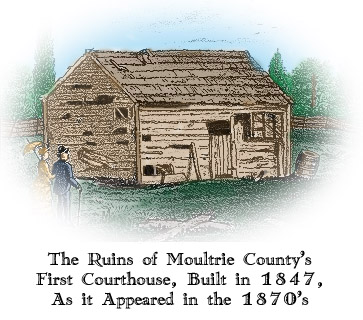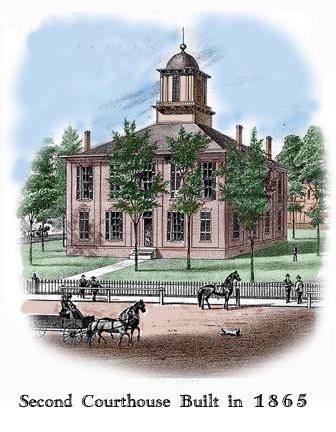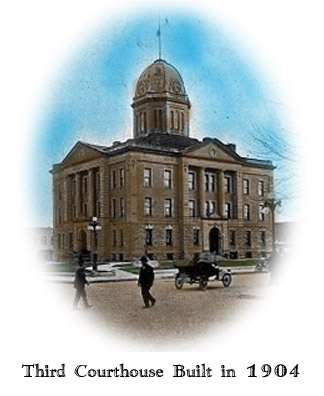This web site is dedicated primarily to the history of Moultrie County, a small county in east-central Illinois, and the city of Sullivan, the county seat.
It also contains information about several families who have lived in the area for 150 or more years: the Martins, Edens, Pifers, Taylors, Whites and Davises and related families.
Much of what appears on the site was added in 2011 – including the county newspapers, high school yearbooks and the information about the Edens, Pifers, Taylors, Whites and Davises.
New to Site: My Search for Old John and Isabella Scott Martin
Also new to the site are sections relating to music and Russian Literature


Thanks for visiting this site. You may let me know if you have found it useful, as well as how it may be improved, by sending me an e-mail to edenmartin.info@gmail.com.
This site has been created and is maintained by R. Eden Martin, who grew up in Sullivan and now practices law in Chicago. Eden has been addicted to local history for years, and has edited several texts on the subject–some of which appear on this site. He is a past Chairman of the Board of the Chicago Historical Society.
The Internet and related computer technology offer unprecedented access to local history materials in two respects.
First, materials which have been literally unavailable or very difficult to obtain may now be placed in web sites and made available for people all over the world. For example, one of the basic books on Moultrie County history — t he Combined History of Shelby and Moultrie Counties, Illinois, published in Philadelphia in 1881 — belongs in this category. It is available in a few libraries, but is not easily accessible by most people.
 The opportunity to make texts available is even clearer with respect to writings that have never been published in book form, and probably never will be. One such text is a “common place book” of Moultrie County history written by my grandfather — I.J. Martin. This consists of a memorandum he wrote in 1927 about people who had held public office in or from Moultrie County. It probably is not the sort of document that would warrant separate publication. It has not been checked for accuracy — I’m not sure how much of it could be checked. So it may contain errors. On the other hand, I believe that most of the information is accurate, and it may be helpful to people who have no other information as to their ancestors’ public service.
The opportunity to make texts available is even clearer with respect to writings that have never been published in book form, and probably never will be. One such text is a “common place book” of Moultrie County history written by my grandfather — I.J. Martin. This consists of a memorandum he wrote in 1927 about people who had held public office in or from Moultrie County. It probably is not the sort of document that would warrant separate publication. It has not been checked for accuracy — I’m not sure how much of it could be checked. So it may contain errors. On the other hand, I believe that most of the information is accurate, and it may be helpful to people who have no other information as to their ancestors’ public service.
Another illustration of the utility of the internet to make otherwise inaccessible information available is the Minutes of the Board of Trustees of the Town of Sullivan, Illinois, recording actions of the board during the Civil War years and until April 1 869. These minutes cast indirect light on what was going on in Sullivan just before and during the War, as well as after. Thus, it is unlikely that the Trustees on March 29, 1861, would have passed an ordinance directing the town constable to “quell all disturbances” and “bring forthwith” all offenders before the police magistrate, and authorizing the constable to “call to his aid any male resident of the town,” unless there were a very real concern about the possibility of such “disturbances.” Again, on August 22, 1863, the Trustees appointed a special police force of fourteen men to act with the constable “to preserve order within the limits of” the town. Needless to say, such measures were not taken without a reason, though the minutes do not discl ose what it was. Still later, on June 7, 1865, after the War was over, an ordinance was apparently enacted which imposed fines on “any person … who shall at any time wilfully disturb any of the inhabitants of said Town, by hallowing, singing obscene so ngs or shouting, or by making loud and unusual noises or by traducing, challenging to fight, quarreling with or threatening to impair the person, or property of another ….” Together with numerous entries relating to the licensing of persons to sell var ious kinds of liquor, these minutes suggest that Sullivan was a boisterous and noisy place to live during the Civil War years and after.
The minutes also reflect the efforts of the town leaders to improve the town — for example, by improving the public wells and bridges, directing all adult males to work on the roads (without pay), completing the construction of sidewalks, and prohibiting the “running at large” within the town of dogs and other farm animals.
Second, beyond making texts and data available, the internet and searching technology make it possible to use these materials in a far more efficient way — in particular, to find information quickly that in the past could only be f ound, if at all, after hours or even days of searching. The 1881 Combined History illustrates this technological advantage. The book is not well indexed, so if someone is interested in finding information about an ancestor or a particular subject , the search may take hours — and pertinent information may be overlooked. Now, texts may be placed on a web site and may be searched quickly to identify ancestors or find information about places, people, schools, or other topics.
The newspapers newly available on this site afford an even better example. Using the original paper versions would simply accelerate their disintegration. Microfilm – the old way of preserving them and making them available – is a hard-to-use haystack of information, and not everyone has a microfilm reader. Digitization makes the information available to anyone with a computer, and makes it far easier to find the needles of information hidden in the hay.
 Two notes of caution to the reader: First, neither scanning technology nor proofreading are likely to produce perfectly accurate results. I have tried to make these digital texts accurate — i.e., conform to the texts as originally published. But I know there are errors. The only way for somone who wants accurate information to be absoloutely sure is to check the original texts. (And, of course, they may be wrong too.) Second, to facilitate checking ,these digital texts include the original pagination of the books from which they were taken. The page numbers appear at the bottom of the pages on which they originally appeared. Thus, for example, to check a name or a date, one would look on the page whose number appears below the name or date.
Two notes of caution to the reader: First, neither scanning technology nor proofreading are likely to produce perfectly accurate results. I have tried to make these digital texts accurate — i.e., conform to the texts as originally published. But I know there are errors. The only way for somone who wants accurate information to be absoloutely sure is to check the original texts. (And, of course, they may be wrong too.) Second, to facilitate checking ,these digital texts include the original pagination of the books from which they were taken. The page numbers appear at the bottom of the pages on which they originally appeared. Thus, for example, to check a name or a date, one would look on the page whose number appears below the name or date.
The editor of this web site well understands that this site is only illustrative of what may be done, and that the materials made available here only scratch the surface. A tremendous volume and variety of other documents and data might just as well be made available. Perhaps this site can be expanded in the future to include some such materials. Perhaps other people will develop their own web sites. As such sites are developed, through “cross referencing” visitors to one site m ay be led to other sites which contain other information useful to them.